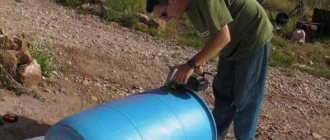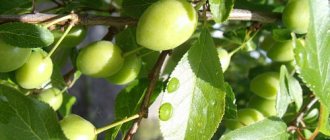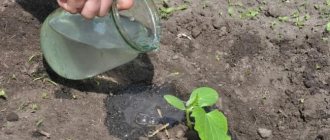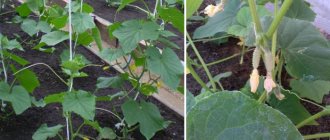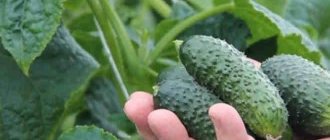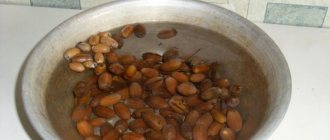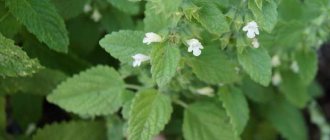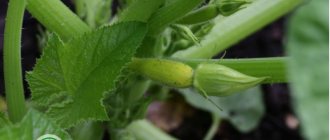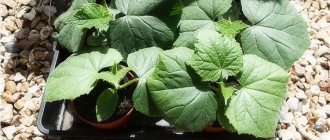Necessary equipment
One of the important issues for a gardener is the choice of greenhouse and its location. The greenhouse is chosen so that it is spacious in size and provides vegetables for the whole family. The optimal ratio of volume to area is 2:1. The height in the greenhouse should be on average 2 meters (more towards the center, less at the sides). The average height of the ridge is 2.5 meters.
A lower height is undesirable, since cucumber vines grow to 3-3.5 meters during the season. And it is not advisable to do it higher, since the air will warm up more slowly. The greenhouse must have a ventilation system. Ideally, it would be automatic.
The greenhouse is placed on a flat surface or with a slight slope to the south. The direction of the greenhouse is the same: from north to south, for better lighting of the plants. A container is placed in the greenhouse to water the cucumbers only with warm water.
How to tie cucumbers in a polycarbonate greenhouse
In a polycarbonate greenhouse, two thick metal trellis wires are stretched along each ridge at a height of 1.8 m from the soil surface with a distance of 30-40 cm between them.
When the cucumber plants form three or four true leaves, tie them to a trellis with twine.
The lower end of the twine is tied with a free loop under the second and third sheets, and the upper end is secured with a sliding loop sequentially:
- one plant - to the right wire;
- the next - to the left, etc.
As the cucumbers grow, each new internode is wrapped with twine, otherwise the plant will slip under the weight of the leaves, become twisted and may break off.
Choosing a variety for indoor soil
Self-pollinating or parthenocapic cucumber varieties are suitable for indoor soil. Both do not need bees. Plants set fruit in closed ground conditions without external intervention. But the process of ovary formation itself occurs in different ways.
Self-pollinating cucumbers are those in which pollination occurs as a result of pollen being transferred from the stamens to the pistil within one flower. In this case, the plant does not have female and male flowers, and accordingly, there are no barren flowers.
Parthenocapic is translated as “virgin”, that is, the cucumber sets without pollination. In adulthood, parthenocapic fruits are always distinguished by their appearance. They have virtually no seeds. And if they exist, they are very tiny, in their infancy.
Among self-pollinating varieties there are varieties and hybrids. The variety differs from a hybrid in that it is a fairly stable form that transmits its basic qualities through the seeds. If you buy a variety of cucumber once, you can plant it year after year, collecting the seeds yourself. Its varietal characteristics will be preserved.
Currently, hybrids are more common; they are designated in their names as F1. Such cucumbers do not transmit their qualities through seeds, so gardeners have to buy them every year. If this is not done, then splitting occurs in the second generation, and it is not known exactly what characteristics will appear as a result.
Let's consider several popular varieties and hybrids for greenhouses and greenhouses:
- Adam F1. Dutch self-pollinating high-yielding hybrid. Valued for setting fruit very early. In just a month and a half you can start harvesting. The second undoubted advantage is the extended fruiting period. Cucumbers are arranged 5-7 together. With insufficient care, 2-4 fruits are tied in the knot. Cucumbers grow not only beautiful in appearance: dark, small, with small thorns. They are delicious both prepared and fresh.
- Zyatek F1. A very popular parthenocapic hybrid. It is loved for its early ripening, the first fruits appear already on the 40th day. The bouquet arrangement of the ovaries is also appreciated. The cucumbers of this hybrid are gherkin-type, cylindrical in shape. They do not grow large; growth stops at 14-16 cm. The fruits of this variety are tasty and productive.
- F1 is the envy of everyone. Despite the fact that this hybrid appeared relatively recently, it has already become popular among gardeners due to its super-yielding and bunched arrangement of fruits. The variety's lashes are powerful. They develop right up to frost and produce an excellent harvest on the side shoots. The thin skin makes it possible to use these fruits both fresh and pickled.
- Well-fed dad F1. One of the salad varieties for indoor soil. Long, smooth, cylindrical fruits are suitable for salad and fresh consumption. This variety is not suitable for whole-fruit canning, but it is just right for preparing lecho and other preparations where chopped fruits are needed. Just like the previous ones, this variety has bunched ovaries, is early ripening and disease resistant.
- Ecole F1. One of the new, very successful parthenocapic hybrids. This cucumber is suitable for those who can preserve pickles (greens 3-6 cm). That is why it can be picked within 35-38 days after the first shoots appear. Ecole's greens are smooth, cylindrical, and grow in bunches. They are collected every day so that they do not overgrow.
- Chinese cold-resistant F1. From the popular series of long and sweet cucumbers. It is suitable for growing in greenhouses, where it is easier to tie it up. Its lashes are powerful and grow quickly. The fruits themselves reach half a meter in length. Smooth and tasty cucumbers can be used in salads or prepared into slices for the winter.
The labels on the bags of cucumbers “Parthenocapic (self-pollinating)” are incorrect. A variety or hybrid can be one or the other. Most often we are talking about parthenocapics.
Why do cucumber leaves turn yellow and dry in a greenhouse?
By the appearance of plants, you can determine which nutrients they lack:
- With a lack of nitrogen, the lower leaves of cucumbers turn yellow, the growth of lateral shoots is inhibited, and the fruits become pointed downwards.
- With a lack of phosphorus, the leaves become smaller, become dark green and dry out quickly.
- With a lack of potassium, a light border appears along the edge of the lower leaves, and the greens become pear-shaped.
All watering and fertilizing are carried out only in the first half of the day, so that the soil dries out by evening, otherwise excess moisture will contribute to the development of diseases.
When ventilating greenhouses, drafts should not be created, as cucumbers cannot tolerate them.
Soil preparation
The preparatory planting process begins with the soil. If you grow cucumbers through seedlings, then first you need to prepare or buy a special mixture in which you will plant the seeds.
Cucumbers love loose and fertile soil, which means that they need the same soil for sowing seeds. The soil should not only be light, but also moisture-retaining, which is very important for cucumbers who like to “drink.” That is why it is better to exclude peat from the composition or use it in small quantities. Store-bought soil, which most often contains a lot of peat, begins to dry out quickly at home.
Watch the acidity, it is peat that has an acidic reaction. In order for cucumbers to develop normally, the pH level should be approximately 6.5-7.
Composition of the substrate for cucumber seedlings:
- turf soil - 3 parts;
- humus or fully matured compost - 2 parts;
- sand - 1 part.
This mixture must be sifted so that there are no large parts. The mixture can be heated in the oven for 10-20 minutes or frozen. It is best to prepare the mixture in advance, in the fall, and put it in a bag. Place the bag on the balcony to kill pathogens. Before sowing, add a liter of vermiculite to the mixture bucket for looseness, a glass of ash and 2 tablespoons of superphosphate.
Preparing seeds for cultivation
Immediately before planting, the farmer must thoroughly disinfect the soil (with a weak solution of hot potassium permanganate) and be sure to prepare the selected seed material for planting. The process consists of treating each grain from possible diseases. To do this, they should be poured with a one percent solution of potassium permanganate (1 g per half glass), left for 20 minutes, and then rinsed under running water. Next, the seeds must be heated in a thermostat or on a radiator at a temperature of 55–60 degrees (leave for 3–5 hours).
Properly preparing seeds for sowing
Previously, before germination, gardeners performed a procedure such as heating the seeds. This is long-term heating of dry seeds near heating devices at a temperature of 30-35 degrees.
Such events have a positive effect on increasing the formation of female flowers in all pumpkin plants.
When preparing self-pollinating and parthenocapic hybrids for sowing, the seeds do not need to be heated, since they do not have the problem of forming barren flowers.
Nowadays, seeds that have already been treated with thiram are often sold. Information is contained on the packaging. The seeds are colored poisonous green as a warning about the toxicity of the applied substance. Thiram is a fungicide that is used against a complex of diseases. Such seeds are not soaked or germinated.
If you have ordinary seeds, then they need to be treated with some kind of fungicide or a saturated solution of potassium permanganate. When there are many varieties, you need to put them in gauze bags and place them in the prepared solution for 15-20 minutes.
After this, you need to wash the seeds and start germination. Germination does not affect the yield, but avoids planting empty seeds.
Before germination, the seeds should be placed in a small amount of water for several hours or overnight to swell. The water should cover the seeds a little so that they do not “suffocate”. There is no need to harden cucumbers because they do not have the cold tolerance gene.
Advantages of the seedling method:
- allows you to get results earlier than when sowing seeds;
- the plant will grow and become stronger in comfortable conditions;
- sorting is possible: you can see which plants develop better and which worse;
- some seeds do not germinate immediately or freeze during seedling growth.
Plants of the same height will be easier to care for. The rest can be planted in a corner so that plants of the same type grow in one place. Such measures will allow you to get an early and healthy harvest.
Correct formation of cucumber bushes in a greenhouse - diagram
In greenhouses, cucumber plants must be shaped so that they have enough light, so that they are less affected by fungal diseases and rot, and grow and bear fruit better.
They begin to form when they have eight to ten leaves.
How to form cucumbers in a greenhouse:
- First, all female flowers and side shoots are removed from the axils of the lower three or four leaves.
- In the next three to four nodes of the main stem, the side shoots are pinched after one leaf, in the next two or three nodes - after two, in the upper part of the stem, three leaves are left on the side shoots.
In the future, you need to make sure that the lashes are not lying on the ground, and that the plants in the greenhouse are well ventilated.
When the main stem reaches the trellis, the formation continues as follows:
- The top is smoothly bent without creasing and twisted twice around a horizontally stretched wire.
- Then the stem is tied to the trellis in two places and pinched.
- All newly grown side shoots, except one, are also pinched, and the remaining shoot is lowered down and pinched at a level of 80-100 cm from the ground.
- Shoots of the second order, that is, lateral shoots growing from the axils of the leaves, are pinched, leaving one leaf.
All whiskers are removed so that they do not interfere with the formation of the cucumber plant, although their presence or absence does not in any way affect the yield.
How to form cucumbers in a greenhouse - video
Growing seedlings
In order for growing seedlings to become an advantage, you need to try to do it correctly. Cucumbers ready for planting should not be overgrown, strong, and without signs of disease. The ideal option is 3-4 sheets.
For sowing, take separate cups at once so that the root system is formed correctly. If this is not possible, then seeds are planted in trays at a distance of 5-10 cm from each other. Seeds must be properly prepared and germinated. The sprouts are small, so-called “beaks”, so as not to break them.
Before planting, the hole in which the seed is placed is spilled with hot water and a weak solution of potassium permanganate. Sprinkle the cucumber seed on top with loose soil in a 2 cm layer.
If possible, cover the container with cucumbers with a damp rag or plastic bag for 1-3 days until seedlings appear.
How to soak cucumber seeds before planting in a greenhouse
To make cucumber seeds germinate faster, first soak them in an epin solution for 12-18 hours, and then germinate them in damp gauze until they hatch.
You can germinate seeds in a box of sawdust, here's how they do it:
- Small sawdust is scalded 2-3 times with boiling water, and the last time a little potassium permanganate is added to the water.
- Cover them with plastic wrap.
- When the sawdust has cooled, squeeze it out and place it in a box in a layer of 6-7 cm.
- Make grooves every 4-5 cm with a depth of 2 cm and sow soaked cucumber seeds at intervals of 2-3 cm.
- Cover them with squeezed sawdust on top in a 2 cm layer.
Cucumber seeds begin to germinate 7-10 days before planting in the greenhouse.
Before emergence, the box is covered with plastic wrap and placed in a warm place (25-28 °C).
When shoots appear, the film is removed and the box is transferred to a bright place with a temperature of 18-20 °C. Three to four days after emergence (in the cotyledon leaf stage), the seedlings are planted in the soil. It is not recommended to keep seedlings in a box.
When picking, plants are easily removed from the sawdust without damaging the roots.
Preparing soil in a greenhouse
Cucumbers love loose and fertile soil. This is what fertile loams are. Clay is too heavy for them and lacks breathability. The sand is loose, but it does not hold water, and without it, cucumbers will not grow. As a last resort, sandy loam is suitable, to which you can add a little heavy clay soil to balance the composition.
In a greenhouse, you need to prepare the soil in advance. You can plant green manure immediately after harvesting vegetables, and dig up with them before frost. The best option would be mustard greens. It will disinfect the soil and enrich it with valuable microelements.
With the onset of winter, you need to throw snow into the greenhouse so that in the spring moisture saturates the soil. After all the snow has melted, the soil in the greenhouse is dug up. The holes must be prepared in advance before planting seedlings. The ideal option is warm ridges, because cucumber is a very heat-loving crop.
They can be made both in autumn and spring. If this is not possible, then humus or compost mixed with ash and double superphosphate is placed in the prepared furrows or holes: half a glass of superphosphate and a liter of ash per bucket. Then sprinkle with 10-20 cm of loose soil.
If you change the soil in the greenhouse in the fall or spring, then you should take into account that you need to take the soil from those areas where the day before you grew vegetables that do not have common diseases with cucumbers: cabbage, onions, carrots, peppers or potatoes.
Possible diseases and pests
To avoid possible infection of plants with diseases, as well as to minimize the likelihood of damage to bushes by pests, the main attention should be paid to prevention, which will be the more successful the more accurately the rules of agricultural technology for cucumbers are followed.
To understand the differences between a disease or the consequences of careless care, all the subtleties can be seen on the classifier:
Diseased plants are usually treated with fungicides, and various insecticides are used against pests, which can be bought at any specialty store. Such drugs are accompanied by instructions that indicate dosages, processing methods, and their frequency.
More important are preventive measures:
- after harvesting the entire crop, all plant debris should be removed from the greenhouse and burned;
- the soil (8-10 cm of the top layer) should also be removed, and instead, a fresh layer of properly prepared soil mixture should be added;
- the room must be disinfected using a sulfur bomb and washed thoroughly (walls, doors, windows, etc.);
- before planting seedlings, the soil in the greenhouse should be completely prepared, disinfected, weeds removed, etc.;
- strictly follow all prescribed rules of agricultural technology for greenhouse cucumbers.
It is also necessary to disinfect the room at the beginning of the planting season - wash the greenhouse again, especially inside, and again use a sulfur bomb (against harmful insects and infections).
In addition to viral, fungal diseases and rot, cucumbers can most often be threatened by pests:
- nematodes,
- ants,
- whiteflies,
- mole cricket,
- scale insect,
- cucumber mosquito,
- slugs,
- melon aphids,
- thrips.
For planted plants there are additional rules for prevention and application of protective measures:
- It is useful to plant onions, garlic, mint in the spaces between the rows;
- timely and regular removal of weeds and plant residues;
- mulching;
- It is useful to sprinkle finely crushed eggshells on a layer of mulch;
- on the vents, windows, doors of the greenhouse, gauze or mosquito nets;
- plants affected by viruses must be immediately but carefully removed (they must be burned away from the site);
- preventive spraying with fungicides and insecticides (every 7-10 days);
- spraying with iodine solutions, potassium permanganate or copper-containing preparations helps against rot;
- Ash and eggshells scattered on the soil will help against slugs;
- Regular inspection of all plants for disease or pest damage.
- You can successfully use nursery plants that attract bees and other beneficial insects, but which pests, which are also carriers of diseases, really dislike.
To ensure favorable conditions for growth and fruiting, as well as for the health of cucumbers, it is very important to provide them with the required microclimate.
Transplanting
Seedlings are planted in the ground when the soil temperature reaches 15°C. This is a very important point. The air temperature in the greenhouse is important, but of secondary importance. Although any shelter for growing cucumbers should be equipped with a thermometer.
Cucumbers love warmth, and soil temperature is especially important to them. For objectivity, you need to take measurements in the morning. Experienced gardeners cover the place where the temperature will be measured with a board or plywood so that the place is not heated by the sun.
A thermometer is placed under the shelter to a depth of approximately 20 cm and left for 15-30 minutes. This way you get a fairly objective result. In order for the soil to heat up faster, it can be covered with plastic film, and also a warm ridge can be made.
But it starts to work only at a certain temperature, so you first need to spill it with hot water and then cover it with film. To activate biofuel on cold days, you will have to do this several times before the start of the season.
We plant seedlings like this. First, we make a hole in the hole already filled with fertilizers the size of the cucumber’s root system. We leave the distance between future plants about 40-60 cm. Then you need to pour warm water with the addition of a weak solution of potassium permanganate for disinfection.
The seedlings must be buried to the cotyledon leaves or the first true one. The soil around is compacted a little, and the surrounding area can be sprinkled with dry soil.
You can additionally mulch the beds with cucumbers to retain heat in the soil.
Care instructions
In order to properly care for the crop, it is necessary to observe timely feeding and watering. Experienced gardeners advise growing cucumbers on trellises; to do this, they are tied to a mesh or wire. This will reduce space and increase profitability.
Expert opinion
Stanislav Pavlovich
Gardener with 17 years of experience and our expert
Ask a Question
The main secrets of high-quality growing season are the creation and preservation of a microclimate in the greenhouse with the necessary conditions and compliance with all agrotechnical work.
Feeding and watering
The soil must be kept moist at all times, avoiding waterlogging. This provokes the appearance of root rot, falling of the ovaries and death of the bush.
Watering rules:
- In spring, plants are watered with warm water, regardless of the time of day.
- In summer, watering should be done in the morning, spending 6–9 liters of water per 1 m2.
Expert opinion
Stanislav Pavlovich
Gardener with 17 years of experience and our expert
Ask a Question
To prevent the soil from compacting, it must be loosened after irrigation.
Rotted leaves, infusion of humus, mullein, and droppings are used for fertilizing. Plants do not like high concentrations of soil solution. Therefore, for 12 liters of water you need to add 120–180 g of organic matter. Let it brew for 2–3 days, then add 35–55 g of superphosphate and 160–260 g of wood ash. Mineral baits include products that are intended for pumpkin crops. During the season, fertilize no more than 6 times.
Bush formation
In greenhouses, the plant is formed into a single stem. A week after planting, the bush is tied up. When it outgrows the trellis, pinch off the top. The lower part is blinded - the flowers and lateral shoots are removed. The next 5–7 shoots from the bottom of the stem are cut off above the first leaf. There should be no more than 2-3 fruits left on one branch. Afterwards, they only check that the braids do not go beyond the row spacing and trim them as necessary.
Loosening
The cucumber root system requires oxygen; this can only be achieved with loose soil. Therefore, you can actively feed the “soil builders” – worms and bugs – with organic matter.
For mulching in the greenhouse, sawdust or mowed lawn grass is used. This will retain moisture in the soil, and the fruits will not directly touch the ground, otherwise they may rot.
Temperature
For greenhouse cucumbers, appropriate temperature conditions are important. Different phases of development require their own optimal maximum and minimum temperatures:
- planting seedlings - 21–23 °C;
- flowering period - 24–27 °C;
- fruiting - 26–31 °C.
Critical temperature indicators:
- developmental cessation - 16 °C;
- complete stop of growth - 11 °C;
- death - 6–9 °C.
Humidity
For the normal development of a plant in a greenhouse, it is necessary to maintain a certain air humidity, which should be in the range of 91–96%. If this condition is not met, ovaries will not form and the cucumbers will slow down.
Light mode
To grow a bush in a greenhouse, it will require 14 hours of lighting. If there is insufficient natural light or due to bad weather conditions, the use of phytolamps or other lighting sources is required.
Ventilation
It is necessary to ventilate the greenhouse, but avoid drafts. In this case, ventilation will be required even for young ovaries in cloudy weather. Otherwise, high humidity will cause the bushes to rot. To do this, it is enough to open the windows and doors in the greenhouse for 2–3 hours a day.
See also: The most productive and best varieties of cucumbers for the Moscow region
Topping
To properly pinch cucumbers, it is necessary to distinguish between female and male inflorescences:
- ovaries are found only on female flowers;
- the stem of the male flower is shorter, unlike the female one;
- female flowers grow in pairs.
Stepsoning
The pinching procedure after tying is done as follows:
- When the 6th leaf appears, all shoots below are cut off.
- When 7–8 leaves are formed, several branches are left from the main stem.
- After the 12th leaf, the tops of the shoots are cut off. On each one leave 2 ovaries and leaves.
Tying up
You need to tie cucumbers when the seedling grows to 35–45 cm. To complete the procedure you will need:
- metal supports;
- strong tensioned wire;
- net;
- long garters made of strips of cotton fabric 4–5 cm wide.
Attention: It is not advisable to pull the thin wire for cucumbers, otherwise during the growth of the bush it will pinch the stem.
Optimal conditions for the growth of cucumbers
There is a reason why cucumbers and tomatoes are planted separately. Although some manage to get good results by growing them together. Cucumbers need special conditions to grow and have a good harvest: light, heat, humidity, watering and others. The growing conditions for cucumbers are almost the same as for all pumpkins.
Watering
Cucumber is a very responsive crop to watering. It must be regular, without this the harvest will not be good. In dry years, it may not exist at all, since the water is instantly absorbed by the soil. Watering in a greenhouse or hotbed should be done frequently; the leaves should not be allowed to wilt.
This feature is associated with the structure of the cucumber root system. It is located close to the soil surface, so the plant does not have the opportunity to take water from the depths, as, for example, tomatoes do. The health of the plant depends on how often you water it. In hot weather, when fruits are forming, this should be done every day.
Cucumbers are recommended to be irrigated using the sprinkling method. With this method, water is poured out in small drops, partially evaporating. This increases the air humidity in the greenhouse, which is very important for cucumbers. The soil is gradually saturated with water, which allows the roots to better absorb moisture.
Water consumption per 1 m2 is approximately 15-25 liters per day or every other day, depending on the weather. When fruits form, water consumption increases and amounts to 20-30 liters.
Do not water cucumbers with cold water. They used to say that this makes the fruits bitter. Now the fruits are genetically sweet, but cold water is not advisable for watering because it increases the likelihood of plant disease.
Feeding
We must not forget about fertilizing. Cucumbers grow rapidly, and modern hybrids produce very high yields. In order for the plant to be able to “feed” them, it is necessary to apply fertilizer 1-2 times a month, literally from the first days.
Fertilizers are organic and mineral. Organic are natural fertilizers. These include manure, green fertilizer from grass, ash, and chicken droppings. When growing seedlings, only ash is used from the listed fertilizers when preparing the substrate for sowing seeds.
Before planting in the ground, seedlings are fed 1-2 times with mineral fertilizers. Preference is given to nitrogen or complex ones with a predominance of nitrogen, because first the plant must increase its green mass and become stronger.
After planting in the ground, cucumbers are not fed for 2 weeks until the plant has completely taken root. In addition, there is usually enough nutrition in the holes. After this, you need to start “feeding” green fertilizer, a solution of mullein, chicken droppings and ash. From the beginning of flowering, potassium fertilizers are added.
Light mode
The time of fruiting, as well as the yield of cucumbers, depends on the intensity of light and the length of daylight hours. The second has a greater effect on plant growth. Cucumbers are short-day plants, so they need a 10-12 hour day to fully develop. During the period of growing seedlings, this is no less important. If there is not enough light, then conditions of 10-hour daylight hours are created using artificial lighting.
Temperature
Cucumber is a very heat-loving crop. If it's cold outside, you can't expect good harvests. In addition, the plants will be weakened, which will affect the increase in morbidity. The average temperature in the greenhouse should be maintained at 17°C. But for the first time after sowing, the temperature should be 25-28 degrees.
That's why it's better to grow cucumbers at home first. Severe cold spells have a negative impact on growth. But too high temperatures are also harmful to cucumbers.
If on hot days the temperature in the greenhouse is above 30C, then you need to ventilate and spray the plant to reduce the temperature.
Humidity
Cucumber has an increased need for air humidity. For cucumbers, this norm is 85-95%. If you compare it with peppers, the difference is very big. Peppers need a moisture content of 60-65%. At low humidity, the process of pollination and fruit set is significantly reduced.
Of the greenhouse crops, cucumber is perhaps the most moisture-demanding crop.
Ventilation
At first, when the cucumber seedlings are still small, you need to ventilate the rooms where they grow very carefully. Cucumbers do not tolerate drafts at all. And in the greenhouse it is necessary to ventilate, especially when the thermometer rises above 30C.
The windows are opened only on one side to avoid drafts.
Bush formation
In order for cucumbers to produce a bountiful harvest and bear fruit for a long time, the plant must be shaped correctly. There are a lot of opinions on this matter, but the overwhelming majority believes that formation is necessary.
Topping
Pinch the cucumber vines as follows:
- the first 40-50 cm - the shoots “blind” completely;
- pinch the next 40-50 cm above the first leaf;
- the next 40-50 cm above the second;
- then 40-50 cm above the third;
- and so on.
Some gardeners cut off the plants' tendrils to save energy. For the same purpose, not all ovaries are left; some are removed. If it is noticed that when fruits are formed in bunches, some do not have enough nutrition and they begin to dry out, then one fruit at a time is left in the axils. In this case, watering and fertilizing are increased.
It turns out like a “herringbone” in reverse. At the end of growth, under the roof, the plants set fruits freely. Some people pinch the whip under the roof so that it does not waste energy on growth. All potential is spent on the formation of fruits.
It has been noticed that without pinching, the yield is significantly reduced.
Stepsoning
Stepsons on cucumbers are only appropriate when the stepsons are removed at the beginning of growth, half a meter above the soil surface. There is no need to do this higher, since many large ovaries are located on the side shoots. The meaning of pinching is that the plant’s forces are released for further growth and development.
For this procedure, carefully bend the leaf and remove the shoot with a cloth or knives. Subsequently, the leaves at the bottom of the vine dry out and the main stem becomes bare. There are many root primordia on it. If you lay the stem in a ring, roots will begin to grow very quickly in this place and the cucumber will have additional nutrition.
Tying up
Cucumbers are tied up in a greenhouse for the following reasons:
- plants in this position are better illuminated by the sun;
- the lashes are ventilated and the cucumbers get sick less;
- they are easier to care for;
- plants do not intertwine with each other;
- Almost 100% of flowers and ovaries are preserved;
- watering and loosening are simplified;
- good visibility when picking fruit.
You need to start tying up the plant at one month of age, when its height reaches 30-40 cm. There are several types of materials from which ropes for cucumbers are made. Everyone chooses the best option for themselves. For some it is rags, for others it is nylon. Some people opt for synthetic twines, which are sold in hardware stores.
The length of one twine is 2-2.5 meters. One end is attached to the ceiling, and the other should freely go down. The lower end is carefully attached between the lower leaves. As the lash grows, it wraps clockwise around the twine.
Planting cucumber seeds in a polycarbonate greenhouse
Sowing sprouted cucumber seeds or planting seedlings with unfolded cotyledons in a polycarbonate greenhouse is carried out in the second ten days of May.
Planting pattern: in one line in the center of the ridge every 30-35 cm.
First, the soil is watered with a warm pink solution of potassium permanganate. Immediately after planting, the seedlings are covered with caps made from two-liter plastic bottles. The lower part of the bottle is cut off by 8-10 cm, and the upper part, with a screw cap, is used as a cap.
When it gets colder, the plants are additionally covered with lutrasil (can be newspapers, cloth or film). In hot weather, bottle caps are removed.
The caps are removed when they begin to interfere with the plants’ development, that is, at the stage of two or three true leaves.
Harvesting
Oddly enough, the regularity of harvesting affects the harvest itself. If cucumbers are not picked on time, they grow and develop further. The plant spends nutrients on them. Especially a lot of microelements go into the formation of seeds.
Therefore, the greens are collected when they reach a size of 10-15 cm. They are picked carefully, holding the whip with one hand so as not to damage them.
During the period when plants begin to bear fruit en masse, cucumbers are harvested once every 1-2 days, depending on the area of the greenhouse.
All diseased, dry and crooked fruits are removed without waiting for them to grow, as they deplete the plant.
Growing conditions
In order for cucumbers in greenhouses to quickly adapt and be able to produce a high-quality harvest, it is recommended:
- Choose varieties of cucumbers intended for growing indoors.
- Maintain optimal temperature and humidity.
- Prepare fertile soil.
- Decide on the method of pollinating flowers.
When choosing a place to install a greenhouse, you should give preference to areas protected from the influence of northern and north-eastern winds. It would be better if a fence was installed near it.
You should not build too large structures; it is enough to build a structure with an area of 2 by 1 meter. This size of the greenhouse allows you to grow vegetables and other crops, regardless of external temperature changes.
Compact greenhouse
Before planting seeds, the greenhouse must be disinfected by treating all wooden components with a solution of copper sulfate, and metal elements should be painted. In addition, you need to remove three to four centimeters of the top layer of soil and add unrotted manure (20-25 kg), lime (200 g), phosphorus and potassium compounds (50 g). All components are designed for 1 sq.m.
After that, you need to dig up the ground. During preparatory activities in the spring, special low-fat manure is introduced, which does not contain any pathogens.
The most effective soil option for cultivating vegetables is the following composition:
- 20% field soil, which is disinfected with a solution of 7% copper sulfate
- 30% humus
- 50% peat
- sawdust
Greenhouse preparation
Before you start planting cucumbers in the greenhouse, you need to prepare it. And this applies to both plantings in a newly built greenhouse, and in the one where the last harvest has already been harvested.
After you have harvested the last crop in the fall, the greenhouse must be treated with a solution of lime chloride. The soil must be dug well, adding lime powder. And just before planting, in the spring, the top layer of soil is removed and the area is completely dug up.
Soil for cucumbers is very important. Experienced gardeners recommend using humus or turf soil. Peat also works very well. All these three components are made up in the following proportions: 50% peat, 30% humus and 20% turf soil. It is also believed that by adding tree bark to peat, the yield can be increased by one and a half times.
In addition, for cucumbers, the soil is also fertilized with ammonium nitrate - 30 g per 1 m2 and potassium sulfate - 50 g per 1 m2.
It is also recommended to make beds using either a strip or wide-row method. There should be at least 80 cm between the rows. If you use the tape method, then the row spacing is 40 cm, and the distance between plants is 25 cm.
Pre-landing preparation
They begin to prepare the polycarbonate structure for the spring planting of cucumbers in the fall, digging up the soil with humus. You can read more about autumn soil preparation in a greenhouse for cucumbers here. But if you missed the season, pre-planting activities are carried out in March, as soon as the soil becomes pliable. After digging, the greenhouse is washed from the inside. To do this, take ordinary warm water and laundry soap. You can also add chemicals to the solution against pests that plagued the plants last year.
As soon as the structure dries, smoke bombs are lit inside at the rate of one per 10 “squares”. This treatment will help disinfect the soil and kill any remaining pest larvae. During the fire, windows and doors are not opened and people do not go inside. After about 4 days, when the checker burns out, the greenhouse is ventilated and further measures are carried out.
Planting dates for borage
The time at which you should start cultivating the crop depends on the planting method. Seeds for seedlings are sown at the end of February. By the end of March-beginning of April, the seedlings will have formed and will be ready to “move” to the greenhouse - they are more resistant to frost.
With the seed planting method, the timing shifts to approximately mid-to-late April or early May. You need to focus on the temperature in the greenhouse; it should be quite high and constant.
Seed preparation
Before preparing seeds, read the information on the packaging. The manufacturer could carry out the necessary manipulations on his own, and your intervention will only harm the seed.
Before planting, seeds are calibrated, disinfected, and then dried in a warm place and hardened. When sorting through material, it is important to remove spoiled, small or damaged specimens. The remaining seeds are placed in a saline solution for an hour - a teaspoon per glass of water, and then those that float are thrown away. The “good” ones need to be washed under running water, poured into a sieve or wrapped in cotton cloth.
For disinfection you will need one of the solutions:
- faint pinkish with potassium permanganate;
- with hydrogen peroxide at a concentration of 2-3%;
- with boric acid at the rate of half a teaspoon per glass of water.
The temperature of the soaking liquid should be slightly higher than body temperature. The seeds are wrapped in cloth and dipped into the solution: for 15 minutes when using potassium permanganate, for 7-8 - peroxide, for 2 hours if using boric acid. Afterwards, the material is removed and washed well in clean water. Warming of the seed material is carried out for better flowering and protection against viruses. The seeds are placed on a radiator or any other heating element for about an hour, the temperature of which does not exceed 65°C.
Hardening is necessary so that the seedlings are more resistant to changes in environmental conditions. To do this, place the seeds on a damp cloth and put them in the refrigerator for a day. You need to choose a place away from the freezer.
To avoid fungal diseases of seedlings or rot, seeds can also be soaked in Fitosporin according to the instructions, and for better germination - in preparations like Kornevin.
Temperature
Hardened seedlings can withstand a short-term drop in temperature down to -5°C, but seeds, especially in the first days after sowing, need +25-27°C. A fruiting plant will need 18-22°C during daylight hours and 12-15°C at night. The temperature must be maintained at approximately the same level - some varieties of cucumbers do not tolerate drafts and overheating.
Humidity
The air humidity inside the structure should also be constant, at the level of 87-88%. It is raised by installing open containers of water in the greenhouse, and lowered by ventilation.
The soil
In autumn, the soil is disinfected and fertilized with organic matter. For disinfection, special preparations such as “Phytocide” or copper sulfate at a concentration of 7% are used. After a month, the soil is “fed” with rotten leaves or manure.
In early spring, a mixture of two parts peat and part humus, enriched with rotted sawdust of coniferous trees, is added to the greenhouse soil at the rate of a glass per 5 liters. After this, the soil is dug up, smooth ridges are formed and the top layer is loosened.
Choosing the right variety
Before learning the secrets of growing cucumbers in a greenhouse and starting to breed them, you should choose a plant variety. Cucumbers are divided into several groups, among which there are special varieties for greenhouses. At the same time, they are quite diverse and have their own characteristics.
Emelya
A fairly young, early-ripening variety of cucumbers for private gardens and greenhouses. Since the technology for growing cucumbers in a greenhouse is very simple, even people who have not done this before can grow them.
The fruits begin to ripen 30-45 days after the seedlings are planted in the soil. The bushes of this variety are indeterminate and vigorous. Covered with a lot of green leaves.
The fruits reach 20 cm in length. The taste of cucumbers is not bitter and even slightly sweet. Emelya boasts maximum yields of 15 kg per square meter. If you know how to care for cucumbers in a greenhouse, you can increase the yield several times.
This variety also has good cold resistance, so you don’t have to worry about what temperature it should be when growing cucumbers.
Courage
An early-ripening type of cucumber that grows very quickly and ripens within 40 days. The plant does not require care, so it is ideal for people who do not want to understand how to care for cucumbers. However, the optimum temperature for growing must still be maintained.
More than 10 ovaries can form on one Courage bush. The largest fruits are 15 cm in length and weigh 150 grams. They are dark green in color and have a frequently tuberculate surface. The peculiarities of the fruits include their preservation, which is two weeks. Courage is also distinguished by its resistance to many common diseases, which include:
- root rot;
- cucumber mosaic;
- downy mildew.
Masha F1
An early variety that ripens a month after planting in a greenhouse. The bushes of the plant are determinate and low-growing. They do not require tying to additional supports or pinning. Cucumbers are covered with small green leaves and inflorescences. All flowers on cucumbers are female, so gardeners do not have to worry about pollinating them. The fruits of this variety are cylindrical.
On average, the fruits grow to 5-7 cm in length. However, people who know how to care for greenhouse cucumbers get a larger harvest.
It is recommended to plant seedlings in early spring, in early or mid-March. Bushes do not like too low temperatures, so the minimum temperature for cucumbers should be at least 15-20 degrees Celsius. If it is lower, the plant will not be able to grow and develop normally. Also, when growing, you need to monitor the length of daylight hours. It should be about 14-15 hours a day. Such conditions are most suitable for obtaining a good harvest.
Mazay F1
An early ripening variety that is recommended to be planted in tunnels or greenhouses. However, the most popular is growing cucumbers in a polycarbonate greenhouse. Some residents of the southern regions of the country also plant them in open ground, but in this case the bushes may suffer from possible night frosts.
Mazai differs from other varieties in the size of the fruits, which grow up to 15-17 cm. The weight of each cucumber reaches 140 grams. Zelentsy are covered with rather large tubercles and have a cylindrical shape. The taste is characterized by a complete absence of bitterness.
To obtain a high-quality harvest, the correct agricultural technology for growing cucumbers in a greenhouse must be used. If you do not care for this variety well, then the bushes will have very few fruits.
See also
Why do the leaves of balcony cucumbers dry out and develop yellow spots? What to doRead
Marinda F1
Quite a popular early ripening variety, which is grown in film greenhouses and greenhouses. The first cucumbers appear on the bushes 50 days after planting the seedlings. Marinda does not require careful care, so even beginners can grow such cucumbers in a greenhouse.
The bushes of the plant are not too dense, which makes harvesting easier in the future. The fruits are dark green in color, their weight reaches 80 grams, and their length is 10 cm. The flesh of the fruit is quite crispy and hard. From one square meter you can collect more than 40 kg of young cucumbers.
Marinda is resistant to many diseases. She rarely suffers from spotting, scab, mosaic and powdery mildew.
Care
Caring for cucumber seedlings in polycarbonate greenhouses mainly consists of ensuring that the vines, root system and fruits are not damaged due to temperature changes, unsuitable humidity or diseases. One of the main points of care is the garter. This material will tell you how to tie cucumbers in a polycarbonate greenhouse.
Irrigation scheme
If you are just planning to place a polycarbonate structure for cucumbers on the site, position it so that groundwater lies at a depth of about 1.5 meters. This will help increase soil moisture and make maintenance easier.
You need to water the plant before or after intense heat 1-2 times a day, paying attention to soil moisture. It should not be allowed to be dry or literally floating in water. Cucumbers are treated by sprinkling, otherwise the liquid lingers on the leaves and fruits and causes burns. The water for irrigation should be lukewarm; cold water can cause the sprouts to rot and hurt. You can read more about fertilizers for cucumbers here.
Fertilizing during cultivation
Cucumbers in the greenhouse are fertilized as needed, paying attention to the quality of the plants and fruits. They usually feed 3-5 times:
- At the beginning, for the correct formation of leaves and vines, the plant needs nitrogen-containing additives. You can dilute 20 grams of granules in 10 liters of water yourself or use semi-finished Agricola Forward.
- When ovaries appear on the lashes, a second feeding is applied. For 10 liters of water add 2 tablespoons of Effekton-O, 1 each of urea and potassium sulfate.
- The subsequent ones occur during the fruiting period. The soil in the greenhouse is watered with a solution of water and fertilizer for cucumbers from the same “Agricola” or the universal “Vegeta”.
Agricola is a water-soluble fertilizer. The price per pack is 29 rubles.
Disease Prevention
Prevention of diseases common among cucumbers is based on proper preparation of soil and seeds, plant care and timely treatment against pests. To kill aphids and other insects, use ready-made products or homemade tinctures with hot pepper and garlic. The cleaned head or 3 small cut pods are poured with 3 liters of water, left for 4 hours and the seedlings are sprayed. How to deal with aphids in a greenhouse on cucumbers is described at this link.
It is useful to install mosquito nets on the greenhouse ventilation windows; they will protect against whiteflies.
Garter
It makes sense to provide support for sprouts when they stretch 25-30 centimeters. To begin with, the stems are carefully tied to a vertical support, and as they grow, they are twisted around it.
Pest and disease control of cucumbers
Cucumbers, like all other plants, are susceptible to various diseases. Some of the most common ones will be discussed.
Root rot
Characterized by the appearance of yellowness and wilting. If you dig up part of the stem, you will find that it is cracked and brownish. To avoid this, it is necessary to water the plant only with warm water; when planting seeds, do not plant them very deeply. It is necessary to maintain the humidity regime, avoiding excessive waterlogging.
To get rid of rot on already damaged plants, expose the stem to the very root and sprinkle it with ash or chalk. You can also treat the plants with a solution consisting of 0.5 liters of water, 3 tbsp. l. lime and 1 tsp. copper sulfate.
Powdery mildew
The most common disease. It is characterized by the appearance of a white spot on the leaves, which subsequently covers the entire leaf blade.
This is most often associated with high humidity and density of crops, temperature changes, the presence of weeds, as well as watering with cold water.
This disease is eliminated by removing damaged leaves or treating them on both sides with liquid cow manure with urea, which is prepared based on 10 liters of warm water, 1 liter of manure and 1 tbsp. l. urea. In addition to this solution, you can also use 0.3% colloidal sulfur (25-30 g of sulfur per 10 liters of water). It is also necessary to add potassium fertilizer.
Downy mildew
It is characterized by the appearance of yellow-green spots on the leaves.
The cause of the disease is constant moisture condensation - fog or dew, sudden changes in day and night temperatures, as well as cold watering.
To combat this disease, it is necessary to treat with a solution of potassium permanganate, or a solution of urea - 1 g per liter of water. You can also prepare whey with iodine: add 1 liter of milk and 10 drops of iodine to 10 liters of water.
Among chemical preparations, the fungicide “Rizoplan” is recommended.
Cladosporiosis
This is a viral disease that affects fruits.
It is characterized by the appearance of small watery spots on the fruit. Cause of the disease: the use of old plastic film, high humidity and the presence of weeds.
Control methods include treatment with Bordeaux mixture, stopping watering for 6-7 days and applying fertilizers containing potassium sulfate.
As for pests of cucumbers, melon aphids are common among them.
To get rid of this pest, use a soap solution to which onion peels are added (50 g of soap and 500 g of peel are added to 10 liters of boiled water) or a mixture of ash per bucket of water - 250 g of ash, 60 g of soap. Processing is carried out twice every five days.
Among chemical preparations, Fitoverm in ampoules and Iskra in tablets are good options. After treatment, the area must be covered with polyethylene for a day.
Spider mites are also very common.
To combat it, measures such as moistening the soil, removing weeds are used, and it is also necessary to replace the top fertile layer every year.
An effective method is to spray cucumbers with an onion mixture containing 1 cup of finely chopped onion, 1 tbsp per 10 liters of water. a spoonful of liquid soap and black pepper (ground), 3 tbsp. spoons of wood ash (ash). Treat with this solution twice every five days.
You can also prepare an infusion: add 60 g of finely grated hot pepper, 5 tbsp. to a bucket of water. spoons of ash and 1 tbsp. spoon of soap.
Other pests and ways to combat them are discussed in this video.
